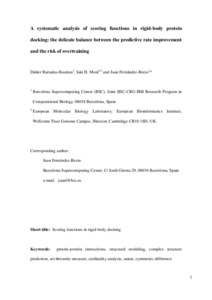Mostra el registre d'ítem simple
A systematic analysis of scoring functions in rigid-body protein docking: The delicate balance between the predictive rate improvement and the risk of overtraining
| dc.contributor.author | Barradas-Bautista, Didier |
| dc.contributor.author | Moal, Iain H. |
| dc.contributor.author | Fernández-Recio, Juan |
| dc.contributor.other | Barcelona Supercomputing Center |
| dc.date.accessioned | 2017-07-25T14:10:33Z |
| dc.date.available | 2018-07-03T00:30:34Z |
| dc.date.issued | 2017-07 |
| dc.identifier.citation | Barradas-Bautista, D.; Moal, I. H.; Fernández-Recio, J. A systematic analysis of scoring functions in rigid-body protein docking: The delicate balance between the predictive rate improvement and the risk of overtraining. "Proteins", Juliol 2017, vol. 85, núm. 7, p. 1287-1297. |
| dc.identifier.issn | 0887-3585 |
| dc.identifier.uri | http://hdl.handle.net/2117/106838 |
| dc.description.abstract | Protein-protein interactions play fundamental roles in biological processes including signaling, metabolism, and trafficking. While the structure of a protein complex reveals crucial details about the interaction, it is often difficult to acquire this information experimentally. As the number of interactions discovered increases faster than they can be characterized, protein-protein docking calculations may be able to reduce this disparity by providing models of the interacting proteins. Rigid-body docking is a widely used docking approach, and is often capable of generating a pool of models within which a near-native structure can be found. These models need to be scored in order to select the acceptable ones from the set of poses. Recently, more than 100 scoring functions from the CCharPPI server were evaluated for this task using decoy structures generated with SwarmDock. Here, we extend this analysis to identify the predictive success rates of the scoring functions on decoys from three rigid-body docking programs, ZDOCK, FTDock, and SDOCK, allowing us to assess the transferability of the functions. We also apply set-theoretic measure to test whether the scoring functions are capable of identifying near-native poses within different subsets of the benchmark. This information can provide guides for the use of the most efficient scoring function for each docking method, as well as instruct future scoring functions development efforts. |
| dc.description.sponsorship | Grant sponsor: MINECO BIO2013-48213-R; Grant sponsor: CONACyT (D.B.-B.); Grant sponsor: EC FP7-PEOPLE (I.H.M.) PIEF-GA-2012-327899; Grant sponsor: BSRC (I.H.M.) BB/N011600/1. |
| dc.format.extent | 11 p. |
| dc.language.iso | eng |
| dc.publisher | Wiley |
| dc.subject | Àrees temàtiques de la UPC::Enginyeria biomèdica |
| dc.subject.lcsh | Protein interactions |
| dc.subject.other | Protein-protein interactions |
| dc.subject.other | Structural modeling |
| dc.subject.other | Complex structure prediction |
| dc.subject.other | Set-theoretic measure |
| dc.subject.other | Cardinality analysis |
| dc.subject.other | Union |
| dc.subject.other | Symmetric difference |
| dc.title | A systematic analysis of scoring functions in rigid-body protein docking: The delicate balance between the predictive rate improvement and the risk of overtraining |
| dc.type | Article |
| dc.subject.lemac | Proteïnes--Anàlisi |
| dc.identifier.doi | 10.1002/prot.25289 |
| dc.description.peerreviewed | Peer Reviewed |
| dc.relation.publisherversion | http://onlinelibrary.wiley.com/doi/10.1002/prot.25289/abstract |
| dc.rights.access | Open Access |
| dc.description.version | Postprint (author's final draft) |
| dc.relation.projectid | info:eu-repo/grantAgreement/MINECO//BIO2013-48213-R/ES/DESARROLLO DE NUEVAS METODOLOGIAS DE DOCKING ENTRE PROTEINAS PARA LOS RETOS DE INTERACTOMICA Y MEDICINA PERSONALIZADA/ |
| local.citation.publicationName | Proteins |
| local.citation.volume | 85 |
| local.citation.number | 7 |
| local.citation.startingPage | 1287 |
| local.citation.endingPage | 1297 |
Fitxers d'aquest items
Aquest ítem apareix a les col·leccions següents
-
Articles de revista [374]


